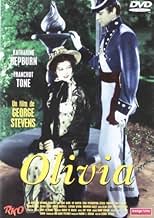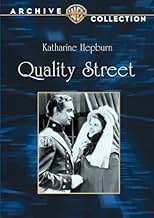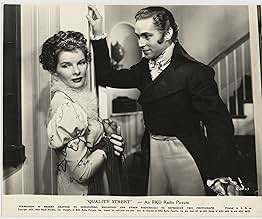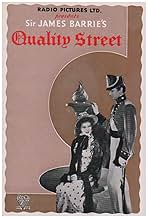NOTE IMDb
6,2/10
1,4 k
MA NOTE
Ajouter une intrigue dans votre langueIn the 1810s, an old maid poses as her own niece in order to teach her onetime beau a lesson.In the 1810s, an old maid poses as her own niece in order to teach her onetime beau a lesson.In the 1810s, an old maid poses as her own niece in order to teach her onetime beau a lesson.
- Réalisation
- Scénario
- Casting principal
- Nommé pour 1 Oscar
- 3 victoires et 1 nomination au total
Sherwood Bailey
- William Smith
- (non crédité)
William Bakewell
- Lt. Spicer
- (non crédité)
Joan Fontaine
- Charlotte Parratt
- (non crédité)
Helena Grant
- Fanny Willoughby
- (non crédité)
Bonita Granville
- Isabella
- (non crédité)
Carmencita Johnson
- Student
- (non crédité)
Payne B. Johnson
- School Boy
- (non crédité)
Darwood Kaye
- Student
- (non crédité)
Florence Lake
- Henrietta Turnbull
- (non crédité)
Helen Lynn
- Girl
- (non crédité)
Lydia McKim
- Schoolgirl
- (non crédité)
Clifford Severn
- Arthur, a Student
- (non crédité)
Avis à la une
On Quality Street, women occupy their time by either witnessing or passing gossip about their friends and neighbors. Whenever there's a gentleman caller, all the neighbors peer out their windows and stare, taking note of how he was dressed, if he brought flowers, and how long he stayed. What else is there to do in 1805?
Katharine Hepburn and her old maid sister Fay Bainter live on Quality Street, and while they primarily socialize with other old maids and gossipers in town, Kate has one particular friend she treasures: the dashing Franchot Tone. She's known Franchot for a year, and when she thinks he's going to propose, the rumor gets spread all over town. It turns out he enlisted in the army instead, and Kate feels humiliated. Ten years later, Franchot comes home from the war. He's a little gray at the temples, and Kate is no longer the blushing beauty he remembers. Can they fall in love again or is it too late?
While it has an intriguing premise, the rest of the film is pretty silly. In order to get him back, Kate throws caution to the wind and acts like a harlot with all the other men in town, and her mischief-making gets a little long in the tooth after a few scenes. It is great fun to see Kate all dolled up, though. She's more beautiful than she's ever looked in her movies, and her flirtations are charming and sweet. I'm fans of both Kate and Franchot, but Fay Bainter was my favorite character in the film. She was unselfish and a wonderful sister, and I wish she'd taken some screen time away from Kate's silliness.
Katharine Hepburn and her old maid sister Fay Bainter live on Quality Street, and while they primarily socialize with other old maids and gossipers in town, Kate has one particular friend she treasures: the dashing Franchot Tone. She's known Franchot for a year, and when she thinks he's going to propose, the rumor gets spread all over town. It turns out he enlisted in the army instead, and Kate feels humiliated. Ten years later, Franchot comes home from the war. He's a little gray at the temples, and Kate is no longer the blushing beauty he remembers. Can they fall in love again or is it too late?
While it has an intriguing premise, the rest of the film is pretty silly. In order to get him back, Kate throws caution to the wind and acts like a harlot with all the other men in town, and her mischief-making gets a little long in the tooth after a few scenes. It is great fun to see Kate all dolled up, though. She's more beautiful than she's ever looked in her movies, and her flirtations are charming and sweet. I'm fans of both Kate and Franchot, but Fay Bainter was my favorite character in the film. She was unselfish and a wonderful sister, and I wish she'd taken some screen time away from Kate's silliness.
This is a gem!--IF you like stories set in this time period to begin with. IF you like the more sentimental acting style prevalent in the 1930's. And probably IF you're female.
This has some resonance with Jane Austen's Persuasion. For me, it felt as if I'd found a new Georgette Heyer story, and on film! This is set in the Regency period in England. It is both romantic and comedic.
Katherine Hepburn gives another great performance, similar to her Jo March in Little Women. I don't find her acting over the top at all. Franchot Tone is a good foil for her--not a great actor, but pretty hunky. Additionally, it has a lovely cast full of the kind of character actors you see in films like the Greer Garson Pride and Prejudice. In this case, it's Fay Bainter, Estelle Winwood, and other notables giving the film a fey charm.
This has some resonance with Jane Austen's Persuasion. For me, it felt as if I'd found a new Georgette Heyer story, and on film! This is set in the Regency period in England. It is both romantic and comedic.
Katherine Hepburn gives another great performance, similar to her Jo March in Little Women. I don't find her acting over the top at all. Franchot Tone is a good foil for her--not a great actor, but pretty hunky. Additionally, it has a lovely cast full of the kind of character actors you see in films like the Greer Garson Pride and Prejudice. In this case, it's Fay Bainter, Estelle Winwood, and other notables giving the film a fey charm.
The original play was set in the early 1800s during the time of the Napoleonic Wars. This is a very cute, funny comedy if you understand that it describes a time when a woman's future was defined by her looks, youth, fertility, and chastity. With the destruction of monastic life in England, the only future for a woman at the time of the play was marriage.
The witty cast and script made the film a lot of fun. Seem to recall reading that the Hollywood actresses of that era wanted to be in this movie, and I can see why - it was a hoot. Especially Eric Blore, who always turned in a good performance.
Western culture at the time of the play valued fertility in marriage highly, and men tended to want wives who were rounder than Miss Hepburn. Other than that, her performance was wonderful as always.
The witty cast and script made the film a lot of fun. Seem to recall reading that the Hollywood actresses of that era wanted to be in this movie, and I can see why - it was a hoot. Especially Eric Blore, who always turned in a good performance.
Western culture at the time of the play valued fertility in marriage highly, and men tended to want wives who were rounder than Miss Hepburn. Other than that, her performance was wonderful as always.
QUALITY STREET (RKO Radio, 1937) directed by George Stevens, stars Katharine Hepburn in her third costume movie in a row (following 1936 releases of "Mary of Scotland and "A Woman Rebels"), and her first to be classified a comedy. Taken from the old stage play by Sir James M. Barrie, the same author whose work was used for Hepburn's 1934 release of THE LITTLE MINISTER, places the now legendary actress for the first of many times in the role of a spinster, but in this case not entirely throughout its 84 minutes.
The setting: "1805 England. Quality Street where a gentleman passerby is an event." Other than an event, Quality Street is also a location of homes where spinster women peep through their window curtains watching everything that goes on. The story introduces Susan Throssel (Fay Bainter), an old maid, hosting her spinster guests, sisters Mary (Estelle Winwood) and Fanny Willoughby (Helena Grant), and Henrietta Turnball (Florence Lake) as they crochet while one reads a book aloud. Phoebe (Katharine Hepburn), Susan's younger sister, arrives with the news of having met a certain individual dashing young man who's finds her fascinating, and will soon be arriving to tell her some important news. Thinking the young man to be interested in proposing marriage to Phoebe, Susan, once engaged to William, a Naval officer, offers her sister a wedding gown she never used. When Doctor Valentine Brown (Franchot Tone) comes to call, he surprises Phoebe with the news about enlisting in the Napoleonic war, stirring up bitter disappointment for her, especially after watching him marching off with the other enlistments. Ten years later, Phoebe and Susan, now spinster teachers at "The Misses Throssel School for Boys and Girls," find the soldiers returning home from war. Upon his arrival, Valentine becomes disappointed to find the once vibrant and beautiful Phoebe, now 30, looking old and tired. Noticing how the other ensigns (William Bakewell and Roland Varno) are wooing the young and silly Charlotte Parratt (Joan Fontaine), Phoebe abandons her drab existence by applying herself with new clothes and hair style. Phoebe's youthful appearance immediately attracts Valentine attention, who fails to recognize her as the girl he once loved. Passing herself off as her visiting flirtatious niece, Olivia, Phoebe not only becomes in Valentine's eyes, but after escorting her to the ball, attracts the attention of Charlotte's suitors as well. Problems arrive as the snoopy Henrietta and the Willoughby sisters suspect both Phoebe and "Livvy" to be one of the same, forcing Phoebe to wonder how long she'll be able to go on with her masquerade without arousing Valentine's suspicion and possibly losing him in the process.
Though the masquerading idea of woman attempting to fool the man she loves by becoming another identity is nothing new, it always seems to go well, especially wondering what will result for its climax. In spite the fact that QUALITY STREET was used as a basis of a silent 1927 MGM comedy starring Marion Davies, Conrad Nagel and Helen Jerome Eddy in the Hepburn, Tone and Bainter roles, the 1937 remake reportedly didn't do as well as the Davies original possibly due to Hepburn's current theatrical failures that labeled her at the time as "box-office poison." Even though QUALITY STREET somewhat resembles Jane Austen's PRIDE AND PREJUDICE (successfully filmed by MGM in 1940) by way of locale, costume setting and spinster characters of the 19th century, the film itself is quite quaint and lavish scale with fine underscoring credited to Roy Webb. Of the supporting players, there's the comic relief of Eric Blore as a recruiting sergeant with a constant blink of an eye towards Patty (Cora Witherspoon); Fay Bainter providing character interest as both sympathetic spinster and mousy schoolteacher afraid of one of her students, a tall bully by the name of William Smith (Sherwood Bailey). It's also interesting spotting Estelle Winwood, a familiar face in many TV shows of the 1960s and 70s very early in her career, along with future Academy Award winner, Joan Fontaine, in two brief scenes, one with Hepburn.
Regardless of its reputation that caused QUALITY STREET to be seldom revived on commercial television back in the 1960s and 70s, the film itself began to surface more frequently later on with revivals on public television, home video (1980s-90s) and later DVD, cable television (American Movie Classics prior to 1998) and Turner Classic Movies. Alternative versions have usually been found through its opening credits: Title card Movietime" used in place of RKO Radio logo commonly shown in sixties and seventies; a brief glimpse insertion from an early RKO title, LET'S TRY AGAIN (1934) before the actual QUALITY STREET title fills the screen, or the restored theatrical opening on TCM. For anyone unfamiliar with both Hepburn and QUALITY STREET, it's worth seeing through once, at least out of curiosity (***)
The setting: "1805 England. Quality Street where a gentleman passerby is an event." Other than an event, Quality Street is also a location of homes where spinster women peep through their window curtains watching everything that goes on. The story introduces Susan Throssel (Fay Bainter), an old maid, hosting her spinster guests, sisters Mary (Estelle Winwood) and Fanny Willoughby (Helena Grant), and Henrietta Turnball (Florence Lake) as they crochet while one reads a book aloud. Phoebe (Katharine Hepburn), Susan's younger sister, arrives with the news of having met a certain individual dashing young man who's finds her fascinating, and will soon be arriving to tell her some important news. Thinking the young man to be interested in proposing marriage to Phoebe, Susan, once engaged to William, a Naval officer, offers her sister a wedding gown she never used. When Doctor Valentine Brown (Franchot Tone) comes to call, he surprises Phoebe with the news about enlisting in the Napoleonic war, stirring up bitter disappointment for her, especially after watching him marching off with the other enlistments. Ten years later, Phoebe and Susan, now spinster teachers at "The Misses Throssel School for Boys and Girls," find the soldiers returning home from war. Upon his arrival, Valentine becomes disappointed to find the once vibrant and beautiful Phoebe, now 30, looking old and tired. Noticing how the other ensigns (William Bakewell and Roland Varno) are wooing the young and silly Charlotte Parratt (Joan Fontaine), Phoebe abandons her drab existence by applying herself with new clothes and hair style. Phoebe's youthful appearance immediately attracts Valentine attention, who fails to recognize her as the girl he once loved. Passing herself off as her visiting flirtatious niece, Olivia, Phoebe not only becomes in Valentine's eyes, but after escorting her to the ball, attracts the attention of Charlotte's suitors as well. Problems arrive as the snoopy Henrietta and the Willoughby sisters suspect both Phoebe and "Livvy" to be one of the same, forcing Phoebe to wonder how long she'll be able to go on with her masquerade without arousing Valentine's suspicion and possibly losing him in the process.
Though the masquerading idea of woman attempting to fool the man she loves by becoming another identity is nothing new, it always seems to go well, especially wondering what will result for its climax. In spite the fact that QUALITY STREET was used as a basis of a silent 1927 MGM comedy starring Marion Davies, Conrad Nagel and Helen Jerome Eddy in the Hepburn, Tone and Bainter roles, the 1937 remake reportedly didn't do as well as the Davies original possibly due to Hepburn's current theatrical failures that labeled her at the time as "box-office poison." Even though QUALITY STREET somewhat resembles Jane Austen's PRIDE AND PREJUDICE (successfully filmed by MGM in 1940) by way of locale, costume setting and spinster characters of the 19th century, the film itself is quite quaint and lavish scale with fine underscoring credited to Roy Webb. Of the supporting players, there's the comic relief of Eric Blore as a recruiting sergeant with a constant blink of an eye towards Patty (Cora Witherspoon); Fay Bainter providing character interest as both sympathetic spinster and mousy schoolteacher afraid of one of her students, a tall bully by the name of William Smith (Sherwood Bailey). It's also interesting spotting Estelle Winwood, a familiar face in many TV shows of the 1960s and 70s very early in her career, along with future Academy Award winner, Joan Fontaine, in two brief scenes, one with Hepburn.
Regardless of its reputation that caused QUALITY STREET to be seldom revived on commercial television back in the 1960s and 70s, the film itself began to surface more frequently later on with revivals on public television, home video (1980s-90s) and later DVD, cable television (American Movie Classics prior to 1998) and Turner Classic Movies. Alternative versions have usually been found through its opening credits: Title card Movietime" used in place of RKO Radio logo commonly shown in sixties and seventies; a brief glimpse insertion from an early RKO title, LET'S TRY AGAIN (1934) before the actual QUALITY STREET title fills the screen, or the restored theatrical opening on TCM. For anyone unfamiliar with both Hepburn and QUALITY STREET, it's worth seeing through once, at least out of curiosity (***)
For her second time in a James M. Barrie role, Katharine Hepburn starred in a remake of Quality Street. Hepburn had previously played a little Scot's minx in The Little Minister also for RKO.
Barrie did right by her again, she was well cast as one of the Throssel sisters of Great Britain of the Napoleonic Era. She and sister Fay Bainter look like they're doomed to be spinsters. Bainter has resigned herself to that fate, but Hepburn still has hopes.
But when she thinks Franchot Tone might be popping the question, he's only around to tell her he's doing what Admiral Nelson expects of every man, his duty to England. In 1805 he enlists in the army and Hepburn and Bainter go on teaching school.
Ten years go by and when Tone doesn't at first recognize Hepburn when he returns, she thinks her prime has passed. But she'll teach Tone a lesson by impersonating her own made up niece. And what a niece, a naughty flirt who entrances all the young blades returned from the wars and doing a job on Tone's ego as well.
Quality Street has a quality history, it was first performed on Broadway by the immortal Maude Adams in 1901 and then made a silent film in 1927 starring Marion Davies and Conrad Nagel. I can certainly see why William Randolph Hearst thought this a good role for Davies. She could be both a crinolined heroine and also use her comic talents as well. Hepburn also gets to use her full talents playing one role straight and imitating a fictitious person at the same time.
Quality Street got an Oscar nomination for Best Musical Score. If it sounds familiar the theme was recycled later on for the frontier film Rachel And The Stranger. It was even given words that were sung on record by that film's star Robert Mitchum.
And George Stevens after doing Alice Adams with Hepburn was assigned this one as well. He'd do even better the third and last time he worked with Hepburn in Woman Of The Year.
Quality Street is a good film, but I'm sure that Depression Era audiences found a Victorian Era comedy a bit dated.
Barrie did right by her again, she was well cast as one of the Throssel sisters of Great Britain of the Napoleonic Era. She and sister Fay Bainter look like they're doomed to be spinsters. Bainter has resigned herself to that fate, but Hepburn still has hopes.
But when she thinks Franchot Tone might be popping the question, he's only around to tell her he's doing what Admiral Nelson expects of every man, his duty to England. In 1805 he enlists in the army and Hepburn and Bainter go on teaching school.
Ten years go by and when Tone doesn't at first recognize Hepburn when he returns, she thinks her prime has passed. But she'll teach Tone a lesson by impersonating her own made up niece. And what a niece, a naughty flirt who entrances all the young blades returned from the wars and doing a job on Tone's ego as well.
Quality Street has a quality history, it was first performed on Broadway by the immortal Maude Adams in 1901 and then made a silent film in 1927 starring Marion Davies and Conrad Nagel. I can certainly see why William Randolph Hearst thought this a good role for Davies. She could be both a crinolined heroine and also use her comic talents as well. Hepburn also gets to use her full talents playing one role straight and imitating a fictitious person at the same time.
Quality Street got an Oscar nomination for Best Musical Score. If it sounds familiar the theme was recycled later on for the frontier film Rachel And The Stranger. It was even given words that were sung on record by that film's star Robert Mitchum.
And George Stevens after doing Alice Adams with Hepburn was assigned this one as well. He'd do even better the third and last time he worked with Hepburn in Woman Of The Year.
Quality Street is a good film, but I'm sure that Depression Era audiences found a Victorian Era comedy a bit dated.
Le saviez-vous
- AnecdotesThe Nestle produced chocolates "Quality Street" were named after J. M Barrie's play by their original manufacturer Mackintosh in 1936.
- GaffesWhen Phoebe and Susan are talking about Mr. B., Phoebe is on a chair and Susan is sitting on a sofa a certain distance near a bonnet. But on the following cuts, Susan's sitting position keeps changing so that she is gets closer and closer to the bonnet.
- Citations
Mary Willoughby: [Goes to the window and looks out] It's that impertinent recruiting sergeant. I passed him on the street yesterday. He closed one of his eyes at me, then quickly opened it again.
[She demonstrates to the other ladies in the room]
Mary Willoughby: I knew what he meant.
[She looks out again and sees the recruiting officer wink at her. She quickly closes the window curtain]
- Crédits fousOpening card:
1805 England Quality Street Where a gentleman passerby is an event.
- ConnexionsFeatured in George Stevens: A Filmmaker's Journey (1984)
Meilleurs choix
Connectez-vous pour évaluer et suivre la liste de favoris afin de recevoir des recommandations personnalisées
- How long is Quality Street?Alimenté par Alexa
Détails
- Durée
- 1h 23min(83 min)
- Couleur
- Rapport de forme
- 1.37 : 1
Contribuer à cette page
Suggérer une modification ou ajouter du contenu manquant

































